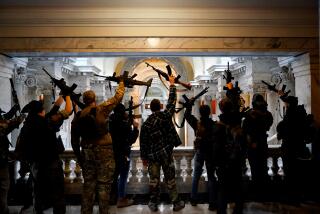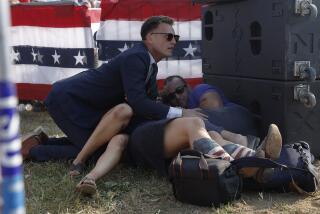Two Major Retailers to End Sales of Toy Guns : Merchandising: Prompted by shooting tragedies, Toys ‘R’ Us and Kay-Bee say they will no longer sell realistic-looking ‘firearms.’
A string of shooting tragedies triggered by toy guns mistaken for the real thing prompted two of the nation’s biggest toy store chains to declare Friday that they will no longer sell realistic-looking toy firearms.
Toys “R” Us, the world’s biggest toy retailer, said it will quit ordering such toys, and a second chain, Kay-Bee Toy Stores, said it will immediately begin to remove the toys from its shelves and destroy them.
While the two big retailers are not the first to do so, the decision by No. 1 Toys “R” Us marks a watershed in the debate over toy guns, analysts and others said.
“Heading into Christmas season, this action is the kiss of death for those who rely primarily on these guns for sales,” said Jill Krutick, an analyst at Smith Barney. “If retailers won’t carry the product, the manufacturers have no place to go.”
Already, such giant toy retailers as Target and K mart have quit selling the items. Other retailers were reassessing their policies in what amounts to a victory for police and anti-crime groups that contend the look-alike firearms perpetuate a gun culture that endangers the nation’s youth.
“What’s happening is that corporations are starting to realize that they do have a measure of accountability concerning issues of violence,” said Khalid Shah, president of the Stop the Violence Increase the Peace Foundation of Los Angeles.
Customers at the Santa Ana Kay-Bee and Toys “R” Us stores hailed the move Friday as a step toward ending violence and preventing innocent deaths. Parents and children agreed that it’s a good decision the toy stores should have made long ago.
“Anything that looks like a real gun can be dangerous,” said Rhonda Hathaway, 26, of Orange. “I think anything that looks like a real gun shouldn’t be sold.”
Inside the Kay-Bee at 17th Street and Grand Avenue, the only toy guns on the shelves were bright- and neon-colored ones, such as a blue “official police” pistol and a red Power Rangers soft-dart target set.
Anthony Alvarado, 28, of Santa Ana, who shopped at Kay-Bee with his infant son, Gabriel, in his arms, said: “It’s going to be safer if they stop selling those toys guns.
“Little boys play with toy guns and then they find real guns--and they try to play with them and injure somebody.”
Alvarado said he will stick to buying his son toy cars and videos.
Outside a Toys “R” Us on Bristol Street, parent Nguyen Hoang, 45, of Santa Ana, said he also favors the toy store’s decision because, “I don’t want kids to die by playing with guns. It will help stop the violence.”
Toys “R” Us, Kay-Bee, Wal-Mart, K mart and Target account for more than 50% of all U.S. toy sales. K mart said it stopped selling those toys 10 months ago and Target said it hasn’t sold such products for years. Wal-Mart officials could not be reached.
*
Friday’s announcements were triggered by a New York City case last month in which Nicholas Heyward Jr., 13, was fatally shot in the stairwell of a housing project by an officer who mistook the youngster’s toy for the real thing. Hours later, a second teen-ager was wounded under similar circumstances.
But they were only the latest of countless incidents across the country in which toy guns--some manufactured to appear frighteningly realistic, others painted or otherwise altered to fool robbery victims--have led to shootings.
“The recent tragedy of the Heyward family and other families lead us to believe that we can have a positive effect by removing toy guns from our stores,” said Ann Iverson, president and chief executive officer of the Kay-Bee chain, which has more than 100 locations in California, including stores in Mission Viejo, Orange, Buena Park, Laguna Hills, Westminster, and Huntington Beach.
Iverson said that the decision is part of the chain’s strategy to “reevaluate our merchandise mix to address what families need today in the way of toys that are fun, safe, creative and developmentally sound.”
The use of toy guns by youngsters, criminals, the mentally unbalanced or others has become commonplace. As recently as Aug. 4 in Los Angeles, a man on a street corner brandishing what turned out to be a toy gun was shot and killed by police.
In a poignant 1983 incident in the Orange County community of Stanton, a police officer who entered an apartment looking for a child reported missing from school shot and killed a 5-year-old boy who pointed a toy gun at him.
A 1992 federal regulation requiring the toys to carry markings such as a brightly colored tip on the barrel has been foiled by customers who paint over them or modify them to create a more realistic appearance, according to Toys “R” Us, which declared that “more drastic measures are now called for.”
Toys “R” Us said it plans to sell those toys now on its shelves but will not purchase such items in the future. Kay-Bee and Toys “R” Us said they will continue to offer certain kinds of water pistols and other toy guns more clearly identifiable as toys. Such products are often produced in bold colors such as red and yellow.
The moves by the two companies surprised some toy industry leaders who thought the issue had been settled by the 1992 federal regulation, said David Miller, who heads Toy Manufacturers of America, a New York-based trade group.
“Toys ‘R’ Us and Kay-Bee are doing something that is within their discretion, and we respect that,” Miller said. “However, the manufacturers of these toys are not doing anything illegal. . . . This is a lawful product that many children enjoy.”
Retail sales of toy guns--including water guns--bring in about $327 million a year, or just 2% of all toy sales, according to the trade group.
Not surprisingly, Chicago-based Strombecker Corp., one of the nation’s leading producers of gun look-alikes, took sharp issue with the retailers’ decision. Myron Shure, chairman, said that retailers continue to sell other products, such as some interactive video games, that feature violence. Strombecker, which calls itself the nation’s oldest toy company, produces such items as the American West silver-colored revolver under its Tootsie label.
“We are an easy target,” Shure said. “They found an easy way to ease their conscience by eliminating a small part of the market.”
However, Jerry Rubin, director of the anti-gun peace group called Los Angeles Alliance for Survival, said studies show that such play often leads to inordinate interest in real guns and to tragedy.
But Rubin was also critical of Toys “R” Us and Kay-Bee: “This is an inadequate solution to a dangerous situation. A pink or green toy gun can be altered too. They should get rid of all toy guns.”
*
Staff writers Lisa Respers and Errol Cockfield and correspondent Debra Cano contributed to this report.
More to Read
Inside the business of entertainment
The Wide Shot brings you news, analysis and insights on everything from streaming wars to production — and what it all means for the future.
You may occasionally receive promotional content from the Los Angeles Times.










